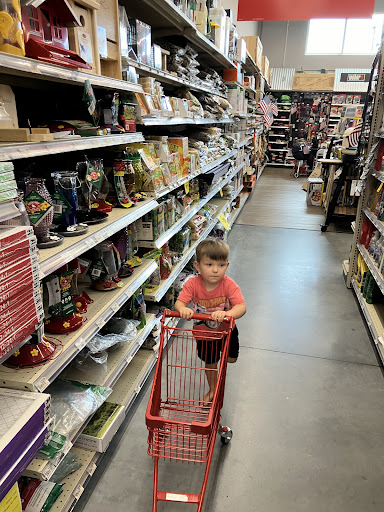Why Your Bench Grinder Needs a Fix
Facing a bench grinder repair can seem like a big job for any workshop. But many common issues are simpler to fix than you might think. Here’s a quick look at the most frequent problems reported by bench grinder owners:
| Symptom | Reported Frequency |
|---|---|
| Won’t turn on | 51% |
| Bad vibration | 23% |
| Smoke from tool | 8% |
| Grinding wheel wobbles | 6% |
| Grinding or squealing sound | 5% |
A bench grinder is a powerful and versatile tool. It’s essential for sharpening, shaping, and grinding various materials. Many homeowners have an inherited grinder, or simply use theirs frequently over the years. Like any hardworking tool, they can encounter wear and tear.
This comprehensive guide will help you understand, diagnose, and fix those common problems. We’ll show you how to get your bench grinder running smoothly and safely again.
The helpful team at Lowcountry Ace has years of experience assisting DIY enthusiasts and professionals with their bench grinder repair needs, ensuring you have the right tools and knowledge for every project. We believe in empowering you to tackle these fixes yourself, saving you time and money.
Similar topics to bench grinder repair:
Grinding machines are power tools designed to grind down a given material, using a fast-spinning abrasive wheel to remove material from a work surface through abrasion. Bench grinders are typically designed to sit on a table or workshop surface, with the part moving across the grinding wheels. They’re indispensable for finishing pieces of metal, decreasing surface roughness, and bringing metal pieces within appropriate tolerance ranges. For more general information on grinding machines, you can check out a general overview of grinding machines.
Safety First: Essential Precautions for Repair
Alright, before we get our hands dirty with any bench grinder repair, let’s talk about something super important: safety! Working with power tools, especially one that spins as fast as a bench grinder, demands our full respect. Skipping safety steps can lead to some real headaches, or worse.
First things first, and this is the absolute golden rule: unplug your grinder! No exceptions. Seriously, before you even think about looking inside, adjusting anything, or starting a repair, pull that plug from the wall. This simple step stops any accidental starts and keeps you safe from electrical surprises.
Next up, let’s gear up with your Personal Protective Equipment (PPE). Think of it as your superhero suit for DIY! You’ll definitely want to wear safety glasses to shield your eyes from any dust, debris, or tiny metal bits that might be hiding. And don’t forget a good pair of gloves to protect your hands from sharp edges, grime, and those little metal shavings.
Now, take a look at your workspace. Make sure your grinder is on a stable work surface. If it’s not bolted down, ensure it’s on something sturdy and non-slip. We don’t want it rocking and rolling during your important bench grinder repair work. Also, good proper lighting is key! You need to see all those small parts clearly to do the job right and spot any hidden issues. No working in the dark here!
A special note about those grinding wheels: they look tough, but they’re actually quite brittle. Always handle grinding wheels carefully. A little chip or crack can turn into a big problem, as a damaged wheel can shatter when in use. We’ll chat more about the “ring test” later, but it’s a neat trick to check if your wheel is sound before you put it back on.
Finally, let’s talk electrical safety. If your repair involves the power cord, the switch, or anything else with wires, and you’re not completely comfortable with electrical work, it’s always smart to seek expert advice before proceeding. Never, ever work on circuits that are still plugged in or “live.” Your safety is worth it!
Taking a few moments for these safety checks means your bench grinder repair goes smoothly and safely. It’s all about being prepared and smart, so you can get your trusty grinder back in action without a hitch.
Diagnosing Common Bench Grinder Problems
When your trusty bench grinder starts acting up, it can feel frustrating. But here’s the good news: most bench grinder repair issues follow predictable patterns, and once you know what to look for, diagnosis becomes much easier.
Think of this as detective work. Your grinder is trying to tell you what’s wrong through the symptoms it displays. A grinding sound here, excessive vibration there, or maybe it just refuses to start at all. Each symptom points toward specific culprits.
The most common problem, affecting about half of all grinder issues, is when the tool simply won’t turn on. This typically points to electrical problems like a damaged power cord, faulty switch, bad capacitor, or motor issues.
Excessive vibration comes in second at 23% of reported problems. When your grinder shakes like it’s having a tantrum, you’re usually dealing with an unbalanced or damaged grinding wheel, worn bearings, or loose mounting bolts.
Less common but more alarming is smoke coming from your grinder, which happens in about 8% of cases. This often signals electrical component failure or motor overheating. If you see smoke, unplug immediately and investigate before using again.
Wheel wobble affects 6% of grinders and usually means something in the wheel mounting system has come loose or worn out. Finally, grinding or squealing sounds occur in 5% of cases and typically indicate worn bearings or components rubbing where they shouldn’t.
Identifying the Source of the Issue
Now comes the fun part – playing detective with your grinder. Start with a thorough visual inspection. Look for obvious red flags like frayed wires on the power cord, physically damaged switches, or grinding wheels that look chipped or loose. Check around electrical components for any signs of burning or melting.
Next, put your ears to work by listening for specific noises. A grinding sound often means metal parts are rubbing against each other or bearings are wearing out. Squealing might indicate friction from a spark guard touching the wheel or bearings crying for help.
Checking for loose components comes next. Gently try to wiggle the grinding wheels – they should barely move at all. Test the tightness of nuts and bolts, especially the arbor nut holding the wheels and any mounting bolts securing your grinder to the bench.
For suspected bearing problems, try the shaft play test. Attempt to move the grinding wheel side-to-side. If there’s excessive movement, your bearings are likely worn and need replacement.
When dealing with electrical issues, basic electrical tests with a multimeter can save you time and guesswork. You can test continuity in the cord, switch, and capacitor to pinpoint electrical failures. Remember to keep the grinder unplugged during any electrical testing!
By working through these diagnostic steps systematically, you’ll quickly identify what’s causing your grinder’s problems. The helpful team at Lowcountry Ace can provide guidance on the right tools and replacement parts you’ll need for your specific repair.
Step-by-Step Bench Grinder Repair Solutions
Now that we’ve covered diagnosis, let’s roll up our sleeves and tackle the actual bench grinder repair. There’s something deeply satisfying about bringing a tool back to life with your own hands. Having the right tools makes all the difference between a smooth repair and a frustrating afternoon.
Before we dive in, let’s gather our arsenal. You’ll likely need wrenches for loosening and tightening nuts, especially that stubborn arbor nut and mounting bolts. A good set of screwdrivers (both Phillips and flathead) will help you access internal components by removing guards and covers. If bearings are in your future, a bearing puller is absolutely essential for press-fit bearings – trust me on this one. For electrical troubleshooting, a multimeter becomes your detective tool for checking continuity, voltage, and capacitance. And of course, never forget your safety glasses and gloves – they’re not optional!
How to Fix a Bench Grinder That Won’t Turn On
This is the big one – the most common problem that shows up 51% of the time. The good news? It’s often simpler to fix than you’d expect.
Start with the basics: power cord inspection. Run your hands along the entire length of the cord, feeling for any cuts, fraying, or exposed wires. Pay special attention to areas where the cord might get bent frequently. Check the plug itself for bent prongs or telltale signs of burning around the connections. A damaged cord isn’t just a repair issue – it’s a serious safety hazard that must be replaced immediately.
Next up is testing the power switch. With your grinder safely unplugged, grab your multimeter and set it to the continuity setting. Touch the probes to the input and output terminals of the switch, then flip it to the “on” position. You should hear a beep or see a reading indicating continuity. No beep? No reading? Your switch has likely given up the ghost and needs replacement.
Now let’s talk about the start capacitor – that little cylindrical component that gives your motor its initial kick. If your grinder hums like it’s thinking about starting but never quite gets there, or starts slowly and bogs down under the slightest pressure, the capacitor is your prime suspect.
Here’s where we need to be extra careful. Capacitors can store an electrical charge even when unplugged, like a tiny electrical time bomb. Before handling it, discharge the capacitor by carefully shorting its terminals with an insulated screwdriver. Look for visual clues of failure: bulging sides, oily leaks, or burn marks are dead giveaways. If your multimeter has a capacitance function, you can test whether it’s still within its rated range.
The centrifugal switch plays a crucial role too. This clever little device disconnects the start winding once your motor reaches proper speed, preventing the start winding from overheating. When it fails, you’ll get that characteristic humming without spinning, or painfully slow starts.
Finally, if you’ve ruled out everything else, you might be dealing with a seized motor. Try manually turning the grinding wheels with the power off. If they feel like they’re stuck in molasses or won’t budge at all, the motor bearings might be seized, or there could be internal motor failure. A burned-out motor often announces itself with a distinctive electrical smell that once experienced, is never forgotten. Unfortunately, seized or burned-out motors usually mean it’s time to consider replacing the motor or the entire grinder.
Eliminating Excessive Vibration and Wheel Wobble
Excessive vibration shows up in 23% of cases, and wheel wobble in 6%. Both can turn your precision grinding into a wrestling match with your workpiece.
Checking wheel balance is your first step. Unbalanced wheels are like having a flat spot on your car tire – they’ll shake your whole world. Sometimes a brand-new wheel comes unbalanced from the factory, or an old one develops uneven wear patterns over time.
Before mounting any wheel, new or suspect, perform the “ring test” – this OSHA-recommended safety check can literally save your eyesight. Hold the wheel horizontally on your fingertips like you’re about to play it like a drum, then gently tap it with a screwdriver handle about an inch from the edge in several spots. A healthy wheel will produce a clear, metallic ringing tone that sounds almost musical. A cracked wheel sounds dull and dead, like tapping on concrete. If it doesn’t ring true, toss it in the trash without a second thought.
Truing and dressing the wheels might sound like fancy barbershop services, but they’re essential maintenance tasks. Truing corrects the wheel’s concentricity, making it perfectly round and centered – critical for eliminating that annoying vibration and tool bounce. Dressing removes glazed or loaded material from the wheel’s surface, exposing fresh abrasive and restoring its bite.
Use a wheel-truing device with a single diamond point. With the grinder running, gently bring the diamond dresser into contact with the wheel, slowly traversing across the face until the wheel runs smooth and true. For more detailed guidance on keeping your grinder in top shape, check out a guide to tuning up your grinder.
Don’t overlook the flanges and washers – those metal discs that clamp the wheel to the shaft. They must be clean, flat, and properly sized. Worn, bent, or incorrectly fitted flanges can cause wobbling that no amount of wheel truing will fix. Make sure they’re correctly installed on both sides of the wheel.
Sometimes the problem isn’t the wheel at all – check those mounting bolts. A loose grinder dancing around on its stand creates vibration that makes precision work impossible. Finally, if you’ve checked everything else and still have severe wobble, you might be dealing with a bent shaft – a serious issue that often means the tool needs to be replaced.
A Guide to Common Bench Grinder Repair for Noises
Those grinding or squealing sounds that show up 5% of the time are your grinder’s way of crying for help. The good news is that most noise issues have straightforward solutions.
Worn bearings top the list of noise makers. They’ll treat you to a symphony of grinding, squealing, or rattling sounds. If the motor shaft feels loose when you wiggle it, the bearings have likely reached the end of their useful life and need replacement.
Sometimes the culprit is simpler – check if your spark guard or tool support is making contact with the grinding wheel. These protective components should maintain a small, safe gap from the wheel. A slight adjustment can eliminate annoying scraping or grinding sounds.
Loose tool rests can vibrate against the grinder body or even touch the wheel, creating noise that sounds worse than it actually is. Make sure all tool rest fasteners are snug.
The arbor nut deserves special attention. If the grinding wheel is loose on the shaft, it’ll create grinding or rattling sounds that can be alarming. With the power off, ensure the arbor nut is securely tightened. One side has a left-hand thread and the other a right-hand thread – pay attention to which way you’re turning!
For lubrication points, most modern bench grinders use sealed bearings that don’t need external lubrication. However, older models or those with sleeve bearings might benefit from a few drops of light machine oil at accessible oil ports or bushings. When in doubt, consult your owner’s manual or ask the helpful team at Lowcountry Ace for guidance.
How to Replace Grinding Wheels and Bearings
Replacing these common wear parts is where bench grinder repair gets hands-on and rewarding.
Replacing grinding wheels starts with the golden rule – unplug that grinder! Remove the wheel guards and tool rests by unscrewing them to gain full access. Now comes the interesting part: loosening the arbor nut. One side has a standard right-hand thread (lefty-loosey), while the other has a left-hand thread (righty-loosey). You might need to hold the opposite wheel or use a wrench to prevent the shaft from spinning.
Once the nut is off, carefully slide off the outer flange, grinding wheel, and inner flange. Installing the new wheel requires ensuring it has the correct arbor hole size. If it comes with reducing bushings, use the one that fits your shaft snugly. The assembly order is inner flange, new wheel, outer flange, then arbor nut. Tighten the nut firmly but don’t overdo it – you can damage the wheel. Reattach guards and tool rests with proper 1/8″ gaps.
Bearing replacement is more involved but totally doable. Start by disassembling everything we just covered, then remove the motor housing cover or split the motor casing to access the motor shaft and bearings. You’ll find the bearings at each end of the motor shaft where it exits the housing.
Removing old bearings requires patience and the right tool. A bearing puller is absolutely worth the investment – it’s the safest and most effective way to remove press-fit bearings. Attach the puller to the bearing and slowly turn the screw to pull it off the shaft. While some DIYers try using punches and hammers, this risks damaging the shaft or housing.
When pressing in new bearings, ensure they’re the correct size and type. Gently tap them onto the shaft using a socket or pipe that matches the inner race – never hammer directly on the bearing itself. Some pros heat the bearing in an oven and cool the shaft in a freezer for easier installation due to thermal expansion and contraction.
Reassemble everything in reverse order, making sure all components are properly seated and tightened. Give the shaft a spin by hand to ensure smooth operation before plugging it back in.
Troubleshooting Motor Issues: Smoke, Slow Starts, and Tripped Breakers
Motor problems can seem intimidating, but many have straightforward solutions once you understand what’s happening.
Smoke from your grinder (reported 8% of the time) demands immediate attention. A shorted stator, capacitor, or switch can cause overheating and smoke – look for burn marks as evidence. These components need replacement when they fail this way. Sometimes the issue is simpler: overheating due to overload happens when you apply too much pressure to the grinding wheel, forcing the motor to work excessively hard. Ease up on the pressure, let the motor cool, and consider replacing a dull wheel.
The centrifugal switch deserves understanding since it’s crucial for proper motor operation. This component helps the motor start by disconnecting the start winding once the motor reaches proper speed. When it fails, you’ll get humming without spinning, slow starts, or failure to reach full speed. Repair usually involves accessing and cleaning or replacing the switch inside the motor housing.
Replacing a faulty start capacitor often solves issues with slow starting, humming, or easy bogging down. After safely discharging and inspecting the old capacitor, ensure your replacement has the same microfarad (µF) rating and voltage as the original.
When your bench grinder trips the circuit breaker (1% of cases), you’re usually dealing with either a short circuit or an overloaded circuit. Short circuits in motor windings, power cord, capacitor, or switch draw excessive current, immediately tripping the breaker. Use your multimeter to test for continuity where there shouldn’t be any. Overload situations are less common for immediate breaker tripping but can occur when grinding very large or hard materials with an undersized grinder, or when using an extension cord that’s too long or thin, causing voltage drop and motor strain.
Proactive Maintenance for a Long-Lasting Grinder
Think of bench grinder repair as something you can mostly avoid with a little regular TLC. Just like your car runs better with routine maintenance, your bench grinder will reward you with years of reliable service when you show it some love.
Regular cleaning is your first line of defense against future problems. Sawdust and metal filings love to sneak into every nook and cranny of your grinder. These tiny invaders can clog up cooling vents, causing your motor to overheat. Even worse, they can create electrical shorts or grind away at moving parts like sandpaper.
Grab a can of compressed air and give your grinder a good blow-out every few weeks. Pay special attention to the motor housing vents and any gaps around the switches. A quick wipe-down of the exterior with a damp cloth keeps things looking sharp too.
How to dress a grinding wheel might sound fancy, but it’s really just giving your wheels a fresh haircut. Over time, grinding wheels get “loaded up” with metal particles or become glazed and smooth. When this happens, they stop cutting efficiently and your poor motor has to work overtime.
Use a wheel dresser to scrape away that outer layer and expose fresh, sharp abrasive underneath. You’ll be amazed at how much better your grinder performs afterward. It’s like the difference between trying to cut with a dull knife versus a sharp one.
Checking fastener tightness is a quick task that prevents big headaches later. Vibration is constantly trying to loosen every nut and bolt on your grinder. The arbor nuts holding your wheels, the mounting bolts securing your grinder to the bench, and all those wheel guard bolts need a periodic check.
Make it part of your routine – maybe once a month, give everything a gentle test with your wrench. Snug things up as needed, but don’t go crazy with the torque. You want them secure, not stripped.
Adjusting tool rests properly does double duty for safety and performance. Keep them within 1/8 inch of your grinding wheel. This prevents workpieces from getting grabbed and pulled into dangerous gaps, while also giving you better support for precise work.
As your wheel wears down, remember to readjust those rests. It only takes a minute but makes a world of difference in how your grinder feels to use.
Storing your grinder properly means finding it a good home when it’s not working. A clean, dry spot away from moisture is ideal. Dust and humidity are the enemies of electrical components and metal parts alike.
If your workshop gets dusty, a simple cover made from an old towel or tarp keeps the worst of it off your grinder. The helpful team at Lowcountry Ace can suggest storage solutions that work well in our humid Charleston climate.
These simple maintenance steps take just a few minutes but can add years to your grinder’s life. Plus, there’s something satisfying about keeping your tools in top shape – it shows you take pride in your work.
Conclusion: Your Grinder is as Good as New
Well, look at you! You’ve made it to the end of our bench grinder repair guide, and hopefully, your trusty tool is now running like new. It might have seemed like a big challenge at first, but with a little patience and the right know-how, you’ve tackled common issues head-on.
Think about it: you’ve learned how to troubleshoot why your grinder won’t turn on, how to banish that annoying excessive vibration, and even how to silence those strange grinding or squealing noises. Plus, you’re now a pro at replacing wear-and-tear items like grinding wheels and bearings, and you even got a peek into basic motor troubleshooting. Pretty impressive, right?
There’s a special kind of satisfaction that comes from fixing something yourself. Not only have you gained valuable skills, but you’ve also saved yourself a good chunk of change compared to buying a brand new grinder. Many older models are built tough and can easily outlast newer ones with just a bit of care and attention. Giving that old workhorse a new lease on life is truly a win-win!
If you find yourself needing a specific replacement part, a new set of grinding wheels, or perhaps a specialized tool to get the job done, the helpful team at Lowcountry Ace is always ready to lend a hand. We’re here to offer expert advice and ensure you have everything you need for your next bench grinder repair project – or any project, for that matter! We proudly serve our friends and neighbors in James Island, Folly Beach, and the wider Charleston, SC area.
Find everything you need at your local Lowcountry Ace Hardware
Lowcountry Ace Hardware: Your one-stop shop for home improvement. We offer quality products from trusted brands and expert advice from our experienced staff. Located on James Island, visit us for tools, hardware, fishing gear, power tools, building materials, grills & smokers, electrical and plumbing supplies, and more.

















